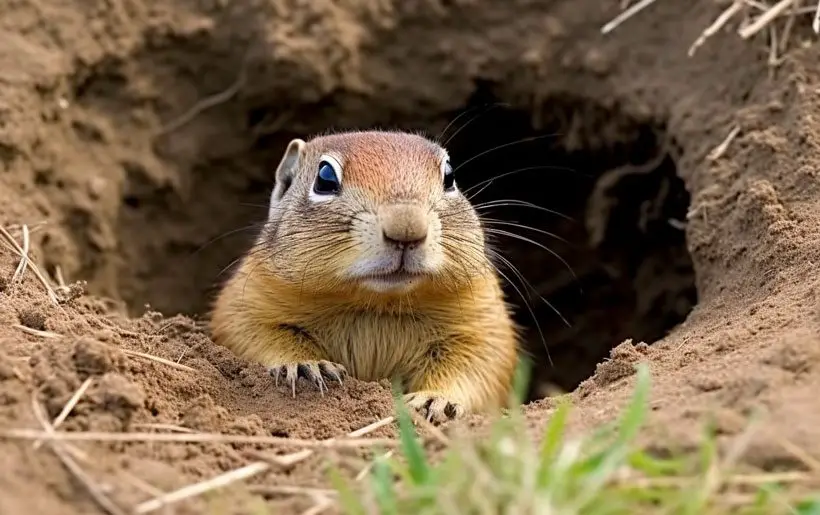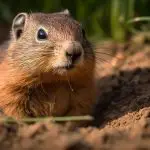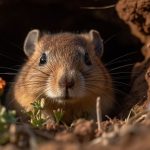What Do Gopher Holes Look Like?
Gophers are small rodents that are common in North America. They are known for their tunneling behavior. And this can cause significant damage to lawns, gardens, and other outdoor areas. So, knowing gopher behavior and burrowing patterns is essential for wildlife management and controlling pests.
So knowing what to do if you detect gophers in your garden, as well as taking preventative measures, will maintain your garden in good shape.
However, what does gopher holes look like? Gopher holes are typically small, circular openings in the ground that are up to 4 inches in diameter. The depth of the hole can vary depending on the type of gopher and the soil conditions. The holes may also have loose soil or debris around the entrance.
We will provide here a comprehensive guide on how to identify gopher holes. Additionally, we will also address common questions related to gopher burrowing behavior. So, keep on reading!
Identifying Gopher Burrows
If you try identifying gopher damage, the presence of gopher burrows is a clear indication. The burrows can damage landscaping, gardens, and crops.

Some common facts about identifying gopher burrows are given below:
- Gopher burrows are small and round, with a 2-4 inches diameter
- The entrance to the burrow is usually plugged with soil, and the soil around the entrance may be mounded or raised
- Gopher burrows are generally deeper than those of other rodents, with some burrows extending up to six feet below ground
Gophers, in general, construct two types of burrows for different purposes.
- The first type is the main burrow, used as a shelter for predators and foraging. These burrows are usually deeper than secondary burrows and contain a nest chamber. Main burrows can usually be between 4 and 18 inches
- The second type is the feeding burrow, used for caching food
Gopher burrows can be distinguished from those of other rodents.
- Ground squirrel burrows are typically larger with multiple entrances
- Mole burrows are often located close to the surface and leave a raised ridge of soil
It is important to take effective measures to control gophers, as they can quickly reproduce and cause significant lawn damage. If you suspect that you have a gopher problem, it is best to take action as soon as possible to prevent further damage.
Detecting Gopher Damage
There are several effective ways to detect gophers. We will know some signs of gopher burrow systems here and the key differences between gopher holes with other rodents.

Signs of Gopher Damage
Various indicators of gopher species exist in your yard, lawn, or garden. We’ll point out these indications one by one shortly so you can recognize them easily.
- Presence of soil mounds: Soil mounds are one of the most obvious signs of gopher damage. Gophers push soil up to the surface as they dig their tunnels, creating mounds ranging from a few inches (like 4 to 18 inches) to several feet (up to 100 feet).
Soil mounds can be found throughout the lawn or garden and may be more prevalent in areas where the soil is soft or loose.

- Destruction of plants: It is another common sign of gopher damage. Gophers are herbivores and as they tunnel through the soil, they may encounter plant roots and eat them, causing the plants to die or wilt.
Above ground, gophers may also eat leaves and stems, leading to further damage.
- Lawn damage: Gophers can loosen the soil as they dig their tunnels, making it more prone to collapse or sink. This can result in areas of the lawn that are sunken or depressed and areas that may be raised due to soil mounds.
Comparison Table: Gophers, Ground Squirrels, and Moles
We will now attempt to compare gophers, ground squirrels, and moles to assess damage severity and other relevant factors.
| Characteristics | Gophers | Ground Squirrels | Moles |
|---|---|---|---|
| Type of rodent | Burrowing rodent | Burrowing rodent | Burrowing rodent |
| Tunnels | Deeper tunnels | Shallow tunnels | More focused on finding food |
| Damage caused | Herbivorous, eats plant roots | Eats plants and seeds | Insectivorous, eats insects |
| Mound creation | Creates soil mounds | May or may not create mounds | May or may not create mounds |
| Damage severity | Can cause severe damage | Can cause damage but is less severe | Can cause damage but is less severe |
In summary, all three rodents – gophers, ground squirrels, and moles – are burrowing rodents that can cause damage to lawns and gardens, have some key differences.
And the severity of the damage caused by each rodent can vary, and humane wildlife removal methods can be used for all three.
Gopher Control Methods
Some effective gopher control methods including trapping, baiting, and exclusion will be discussed here. Each method has its pros and cons, and the most appropriate approach depends on the severity of the infestation and the preferences.

Method 1: Trapping
It is important to note that trapping regulation varies by location, so it is crucial to check local laws and regulations before trapping gophers.
Gopher traps are usually made of metal or plastic, with a spring-loaded mechanism that traps the gopher when it enters the trap. The traps come in different sizes and shapes, but the most common ones are box-type traps and tunnel traps.
They can be purchased at most hardware stores and online, they are relatively easy to use, and can be done by anyone. But it is important to follow the instructions carefully to avoid injury and ensure that the traps are effective.
Trapping requires patience and persistence, as it may take several attempts to catch all of the gophers.
Method 2: Baiting
Baiting is another common method of gopher control. Poison baits are placed in the tunnels, and gophers consume the bait and die. This method can be effective, but it is not as humane as trapping.
The common poison used for gopher control includes zinc phosphide, which are highly toxic. Poisonous baiting should only be used as a last resort and with extreme caution, following the instructions on the label.

Additionally, poisoned gophers can be dangerous to pets and wildlife if they are consumed. Homeowners who choose to use baiting should take precautions to prevent accidental ingestion by other animals.
This approach can be performed by yourself or by specialists. But, because it is exceedingly dangerous, you should exercise caution if you do it yourself to avoid any unwanted circumstances.
Method 3: Exclusion
Exclusion is a method of gopher control that involves preventing the animals from accessing the area. This can be done by installing barriers such as underground mesh or fencing.
Exclusion is often the most effective method for protecting vegetable gardens and other small areas. However, it can be expensive and time-consuming, particularly for larger properties.
Which Method to Use?
When deciding which gopher control method to use, consideration can be based on to whom it is going to be applied.
Homeowners should consider the severity of the infestation, the location of the burrows, and their preferences for the humane treatment of animals.

Trapping is a good choice for those who want to minimize harm to the animals, while baiting may be preferred for those who want a more hands-off approach.
Exclusion is a good choice for those who want to protect specific areas, such as gardens or lawns.
Control Services: Professional vs DIY
Professional gopher control services are available for those who do not want to tackle the problem themselves.
These services provided by pest control companies can be expensive, but they often provide a more comprehensive solution. This may include trapping, baiting, and exclusion methods.
DIY gopher control methods such as trapping or poison baiting are typically less expensive, but they require more time and effort from the homeowner.

Also, some other additional comparisons may help you decide on a better notation. These may include convenience, safety, and guarantee.
So, it depends on you which way you should go. If you don’t mind spending some money, and want the best recovery and protection, professional services might be chosen. Otherwise, it should be DIY.
Gophers are fascinating creatures that can cause significant damage to your yard. If you’re curious about their diet or want to know more about how they compare to prairie dogs, be sure to check out our articles on what gophers eat and prairie dog vs gopher. Our piece on what gophers eat explores their dietary habits, while our article on prairie dog vs gopher provides an in-depth comparison of these two species.FAQs
To know a little more, keep your eyes here.
Q: Are gopher holes harmful to humans?
Generally, gopher holes themselves are not harmful to humans. However, they can pose a tripping hazard and may damage lawn equipment or other machinery.
Q: Do gopher holes attract other pests?
Yes. Gopher holes can attract other garden pests, such as snakes, rodents, and insects that may use the holes as shelter or prey on the gophers. Additionally, the disruption of soil and vegetation can create conditions that are conducive to other pests thriving. For example, weeds or fungal diseases.
Q: How deep do gophers burrow?
Gophers are capable of burrowing tunnels up to 6 feet deep, but the depth of their burrows can vary depending on factors such as soil types and availability of food and water.
Final Thoughts
In summary, the brief analysis of what gopher holes look like has consisted of identifying gopher holes for effective pest control. Understanding the behavior and habitat of gophers is essential in developing strategies to prevent damage to different areas.
These may include gardens, lawns, and other outdoor areas from garden and backyard pests. The implications of this knowledge are significant, as gophers can cause extensive damage to gardens, making preventative measurements a priority for many property owners.
It is also important to implement pest prevention measures, such as removing food sources and habitats to discourage gophers from establishing themselves in the area.
Further research should be done to prevent pests could include investigating non-lethal gopher control methods. These can be using barriers or repellents. Additionally, studying the effectiveness of natural predators can be a good move in controlling gopher populations.
Overall, understanding how to identify gopher holes and manage gopher populations is crucial for maintaining healthy and thriving outdoor spaces.




